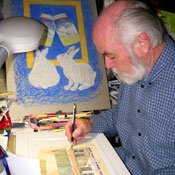Most people who grew up in Mississippi probably recall making mud pies as a child. For the creative pie, you dug up wet, red Mississippi clay and squished it though your fingers, patting and patting, to make that perfect shape. There was nothing more satisfying than making something so nice out of something so messy.
, 62, takes mud art to a whole new level.
Jenkins, originally from Thomastown, Miss., now lives with his wife, Margaret, in Hazlehurst. He has been interested in art his entire life and holds two master's degrees—one in art education and one vocational counseling from Delta State University. He also holds a post-graduate degree from the University of Southern Mississippi in psychometry and is a founding member of the Mississippi Craftsmen's Guild.
Although he wanted to be an artist at a young age, he opted for art education because of practicality. "I wanted to be a full-time artist, but living in the South, that's more of a dream than a reality," Jenkins says.
Then, on a trip to St. Francisville, La., "a few years ago in the fall," Jenkins says, he stopped at a plantation home where the guide showed him old paintings made of mud created by slaves. Jenkins was impressed and intrigued, but the guide couldn't tell him anything about how the slaves had made these remarkable paintings. After searching as far the Smithsonian Institution in Washington, D.C., for information with no results, Jenkins found a kindred spirit in fellow artist Anthony DiFatta.
DiFatta was also interested in mud paintings, but they could only find two other artists in the country making them at the time.
"There were two fellows I found. One, Jimmy Lee Sudduth, from Alabama passed away last year. He was 95. And there's another fellow, Hendrix, who lives in Baton Rogue who's in his 80s. ... The Smithsonian doesn't have anything about anyone who does mud paintings. They wanted to have some of my mind," Jenkins says. And so, mud artist says, "I'm just pursuing it on my own, making my own mistakes."
The artist travels to gravel pits and to Red Bluff in Columbia, Miss., to gather colored clays, which he stores in airtight containers with kitty litter to keep out moisture. He also collects nuts, black walnut shells, hickory bark, seasonal berries for color, and rain water because, he says, "the city water's got stuff that'll change the colors on you, so I use natural water."
Due to the size of the pieces and the materials he uses, Jenkins' mud creations take about 200 hours to make, layering the mud and letting each layer dry in between.
Other than natural, organic mud, Jenkins uses dirt dauber nests, which he grinds into a dust to make a thick paste. He then mixes in blueberries and blackberries into the paste for color. Recently, he's ventured into corn husks for color making, too.
"Everybody that sees the corn husks can't imagine that you could do that with natural materials and something that pretty comes out of it," Jenkins says.
He gets a similar reaction to his mud paintings. "A lot of the time, people don't believe me that it's really made out of mud," he says.
Jenkins likes to stay with the natural media but excels with other materials. He's a basket weaver and has gained notoriety as "the new Walter Anderson" or "Walter Anderson with a sense of humor" with his colored lead pencil drawings.
In 1993, after a period of frustration with his old paintings that had gotten moldy, bent and mildewed in storage, he burned them and began using French colored pencils made of lead instead of wax.
His first project with the colored pencils was animal portraits. He and a friend came up with an exhibit concept based on a question: "What do animals do for fun and entertainment when humans aren't around?"
Carrying his love for animals and art a step further, Jerri Bennett at Community Animal Rescue and Adoption commissioned a limited edition piece (there are 100 prints) from Jenkins to help raise money for the organization and get out awareness about the no-kill shelter and its mission. He did so gladly. The piece will be available starting Friday, Dec. 3, at CARA and will be featured in one of WLBT's Pet-of-the-Week segments.
You can also see Jenkins' work at the Belhaven Market now until Christmas. His mud paintings will be on display at an invitational—an exhibit of various artists—at Brandon Hall in Natchez (Mile Marker 8.5 Natchez Trace Parkway, 601-304-1040) Dec. 18 and April 17, 2011, at the Juke Joint Festival in Clarksdale.



Comments
Use the comment form below to begin a discussion about this content.